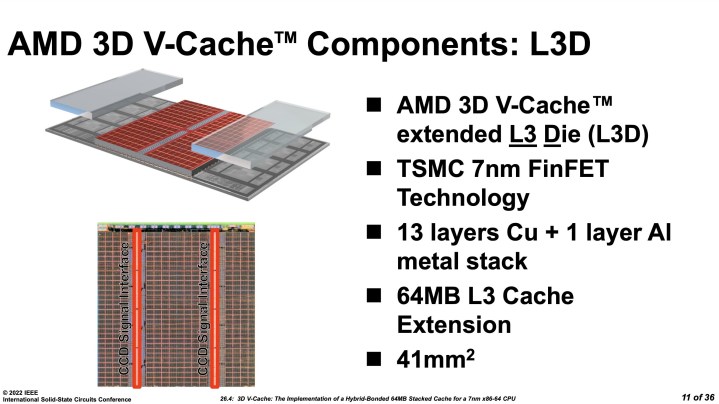AMD is currently readying its new Ryzen 7 5800X3D, featuring a 3D V-cache, and it looks like we may soon have a powerful processor on our hands. AMD has teased that we can expect an up to 15% performance boost over the base Ryzen 7 5800X.
The tech giant talked about the new chip during the International Solid-State Circuits Conference (ISSSC) and revealed more information about its architecture. While the Ryzen 7 5800X3D will certainly be an improvement, will it be enough to compete with Intel’s best processors?

Before AMD moves on to Zen 4 later this year, it plans to release the Zen 3-based Ryzen 7 5800X3D. First confirmed during CES 2022, the processor is said to feature an innovative architecture, and this is exactly what AMD covered during its ISSSC segment. As far as the consumer market goes, this CPU will be the first processor to feature an additional stacked cache.
The new Ryzen 7 5800X3D comes as a successor to the Ryzen 7 5800X, and although AMD has made some substantial changes, the basic Zen 3 chip was already prepared to accommodate the improvements brought on by the new model. As noted by PC Gamer, AMD has designed the cache on Zen 3 in a way that allows future upgrades, in this case, cache stacking.
Every Zen 3 chiplet comes with 32MB of L3 cache split among eight on-die cores, but that number can be increased up to 96MB when you add 64MB of stacked static RAM (SRAM). AMD explained that the stacked chip is attached via copper bonding and retains a small size, measuring just 41mm². This technology is what AMD has used to create its 3D V-Cache used in the consumer CPUs, first found in AMD’s workstation EPYC processors.
AMD’s 3D V-Cache is made out of multiple 8MB parts, each with 1,024 contact points between the V-Cache and each core complex (CCX), adding up to a total of 8,192 contact points when eight 8MB segments are used. This architecture allows for some massive bandwidth, perhaps exceeding two terabytes per second for each 8MB “slice.” Using this architecture results in slightly larger chiplets, so AMD has also had to make adjustments in order to make the processor retain the size of other Ryzen 5000 CPUs.

Ryzen 7 CPUs are also available in higher variants, but it’s pretty unlikely (if not impossible) that AMD will be releasing 3D V-Cache versions of the 5900X or the 5950X. As these more advanced Ryzen chips come with more than eight cores, they’d also require extra power and cooling compared to the Ryzen 7 5800X3D, perhaps to the point where it’s no longer plausible or viable to pursue. AMD has also said that eight-core CPUs are the ideal middle ground for gaming, so it’s likely going to stick to the Ryzen 7 5800X3D.
Until some actual benchmarks of the new AMD CPU emerge, it will be difficult to estimate how it will match up against Intel’s latest and greatest, the Core i9-12900K. However, if the 15% boost in performance proves to be true, it’s very likely that AMD’s latest offering will be able to compete with the high-end Core i9-12900K in terms of gaming. As we get closer to its launch, some benchmarks will undoubtedly begin to leak soon.




